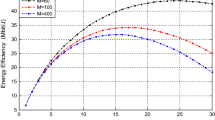Abstract
With the rapid development of information technology, massive MIMO is becoming attractive for the fifth generation (5G) communication because of its outstanding performance in both spectral efficiency (SE) and energy efficiency (EE). Recently, many algorithms have been proposed to improve the EE while achieving high SE in massive MIMO systems. In previous work, the power amplifier (PA) efficiency is always considered as a constant. However, the PA efficiency changes with the output power in reality. In the practical situation, the simplification which treats the PA efficiency as a constant will not get the EE optimization based on our analysis. In this paper, we propose a more general EE model of massive MIMO systems considering PA efficiency as a variable, and investigate a power allocation algorithm based on zero-forcing (ZF) precoding so that we can guarantee the SE and EE at the same time. Simulation results show the trade-off between EE and SE, demonstrate the distinction with previous work, and imply that relatively higher transmit power will be more energy efficient.
创新点
功率放大器的效率会随输出功率不同而改变,与以往将功放效率作为常数的研究不同,本文将功放效率考虑为输出功率的函数,在功放效率可变的情况下,探究使下行链路能量效率最大化的资源分配方案,证明了在恒包络预编码情况下,简化后的优化的问题是凸优化问题,可以利用迭代算法进行求解,仿真结果表明,在高频谱效率区域,功放效率对系统能量效率有明显的影响。
Similar content being viewed by others
References
Tse D, Viswanath P. Fundamentals of Wireless Communication. Cambridge: Cambridge University Press, 2005
Lau V K N, Kwok Y K. Channel-Adaptation Technologies and Cross-Layer Design for Wireless Systems with Multiple Antennas—Theory and Applications. Hoboken: John Wiley & Sons, Inc., 2005
Fettweis G P, Zimmermann E. ICT energy consumption—trends and challenges. In: Proceedings of 11th International Symposium on Wireless Personal Multimedia Communications, Lapland, 2008
Aktas D, Bacha M, Evans J, et al. Scaling results on the sum capacity of cellular networks with MIMO links. IEEE Trans Inform Theory, 2006, 52: 3264–3274
Mazetta T L. Noncooperative cellular wireless with unlimited numbers of base station antennas. IEEE Trans Wirel Commun, 2010, 9: 3590–3600
Chen Y, Zhang S, Xu S, et al. Fundamental trade-offs on green wireless networks. IEEE Commun Mag, 2011, 49: 30–37
Rusek F, Persson D, Lau B K, et al. Scaling up MIMO: opportunities and challenges with very large arrays. IEEE Signal Process Mag, 2013, 30: 40–60
Ngo H Q, Larsson E G, Marzetta T L. Energy and spectral efficiency of very large multiuser MIMO systems. IEEE Trans Commun, 2013, 61: 1436–1449
Xu Z, Han S, Pan Z, et al. EE-SE relationship for large-scale antenna systems. In: Proceedings of IEEE International Conference on Communications Workshops, Sydney, 2014. 38–42
Bjornson E, Hoydis J, Kountouris M, et al. Massive MIMO systems with non-ideal hardwares: energy efficiency, estimation, and capacity limits. IEEE Trans Inform Theory, 2014, 60: 7112–7139
Bjornson E, Sanguinetti L, Hoydis J, et al. Designing multi-user MIMO for energy efficiency: When is massive MIMO the answer? In: Proceedings of IEEE Wireless Communicatongs and Networking Conference, Istanbul, 2014. 242–247
Joung J, Ho C K, Sun S. Power amplifier switching (PAS) for energy efficient systems. IEEE Wirel Commun Lett, 2013, 2: 14–17
Joung J, Ho C K, Sun S. Spectral efficiency and energy efficiency of OFDM systems: impact of power amplifiers and countermeasures. IEEE J Sel Area Commun, 2014, 32: 208–220
Raab F H, Asbeck P, Cripps S, et al. Power amplifiers and transmitters for RF and microwave. IEEE Trans Microwave Theory, 2002, 50: 814–826
Li G Y, Xu Z, Xiong C, Yang C, et al. Energy-efficient wireless communications: tutorial, survey, and open issues. IEEE Wirel Commun Mag, 2011, 18: 28–35
Kim H S, Daneshrad B. Energy-constrained link adaptation for MIMO OFDM wireless communication systems. IEEE Trans Wirel Commun, 2010, 9: 2820–2832
Xu Z, Yang C, Li G Y, et al. Energy-efficient configuration of spatial and frequency resources in MIMO-OFDMA systems. IEEE Trans Commun, 2013, 61: 564–575
Hussaini A s, Elfergani I T E, Rodriguez J, et al. Efficient multi-stage load modulation radio frequency power amplifier for green radio frequency front end. IET Sci Meas Technol, 2012, 6: 117–124
Krauss H L, Bostian C W, Raab F H. Solid State Radio Engineering. Hoboken: John Wiley & Sons, Inc., 1980
Mohammed S K, Larsson E G. Per-antenna constant envelope precoding for large multi-user MIMO systems. IEEE Trans Commun, 2013, 61: 1059–1071
Boyd S P, Vandenberghe L. Convex Optimization. Cambridge: Cambridge University Press, 2004
Imran M A, Katranaras E, Auer G, et al. Energy efficiency analysis of the reference systems, areas of improvements and target breakdown. Technical Report INFSO-ICT-247733. 2011
3GPP. Coordinated multi-point operation for LTE physical layer aspects. TR 36.819 v0.0.1. 3GPP Release 11. 2011. http://www.3gpp.org/
Author information
Authors and Affiliations
Corresponding author
Rights and permissions
About this article
Cite this article
Guo, Y., Tang, J., Wu, G. et al. Power allocation for massive MIMO: impact of power amplifier efficiency. Sci. China Inf. Sci. 59, 1–9 (2016). https://doi.org/10.1007/s11432-015-5513-5
Received:
Accepted:
Published:
Issue Date:
DOI: https://doi.org/10.1007/s11432-015-5513-5




